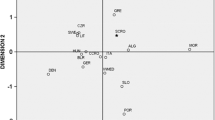Abstract
The X-STRs are important tools in forensic application, particularly in complex cases of kinship testing. In deficiency paternity testing when alleged father cannot be typed, investigation of X-STR markers yields the desired information. Blood samples were collected from unrelated individual (118 females and 94 males) and 84 trios families (father, mother and daughter). DNA extraction from whole blood was performed with Phenol chloroform method. Five X-linked STR markers DXS6800, DXS7133, DXS6797, DXS981 and GATA165B12 were selected. The amplicons were analyzed through ABI 3100 Genetic Analyzer. Pentaplex PCR system was developed for multilocus amplification at the same time. For each locus 4–9 alleles were noted. Altogether, 32 alleles were observed from five markers. Eighty-four trios families were analysed to check the mutation rate and no mutation was observed. Stutter peaks were observed maximum at locus DXS6797 (12.44%) while the minimum at locus DXS7133 (4.5%). For sensitivity study, amplification of X chromosomal short tandem repeats loci was successfully performed using 0.15 ng quantity of DNA as template. In conclusion; this pentaplex represents a convenient method to study X chromosome markers. It works with reasonable amounts of DNA and is suitable for paternity cases.
Similar content being viewed by others
References
Szibor R, Krawczak M, Hering S et al (2003) Use of X-linked markers for forensic purposes. Int J Legal Med 117:67–74
Shin SH, Yu JS, Park SW et al (2005) Genetic analysis of 18 X-linked short tandem repeat markers in Korean population. Forensic Sci Int 147:35–41. doi:10.1016/j.forsciint.2004.04.012
Gill P (2002) Role of short tandem repeat DNA in forensic casework in the UK past, present, and future perspectives. Biotechniques 32:366–372
Robino C, Giolitti A, Gino S et al (2006) Development of two multiplex PCR systems for the analysis of 12 X-chromosomal STR loci in a northwestern Italian population sample. Int J Legal Med 120:315–318. doi:10.1007/s00414-006-0115-9
Pereira R, Gomes I, Amorim A et al (2007) Genetic diversity of 10 X chromosome STRs in northern Portugal. Int J Legal Med 121:192–197. doi:10.1007/s00414-006-0144-4
Moretti TR, Baumstark AL, Defenbaugh DA et al (2001) Validation of short tandem repeats (STRs) for forensic usage: performance testing of fluorescent multiplex STR systems and analysis of authentic and simulated forensic samples. J Forensic Sci 46:647–660
Walsh PS, Fildes NJ, Reynolds R (1996) Sequence analysis, characterization of stutter products at the tetranucleotide repeat locus vWA. Nucleic Acids Res 24:2807–2812. doi:10.1093/nar/24.14.2807
Hauge XY, Litt M (1993) A study of the origin of ‘shadow bands’ seen when typing dinucleotide repeat polymorphisms by the PCR. Hum Mol Genet 2:411–415. doi:10.1093/hmg/2.4.411
Maniatis T, Fritsch EF, Sambrook J (1982) Molecular cloning: a laboratory manual. Cold Spring Harbor Laboratory, New York
Bar W, Brinkmann B, Budowle B et al (1997) DNA recommendations. Further report of the DNA commission of the ISFH regarding the use of short tandem repeat systems. International society for forensic haemogenetics. Int J Legal Med 110(4):175–176. doi:10.1007/s004140050061
Szibor R, Edelmann J, Hering S et al (2003) Cell line DNA typing in forensic genetics—the necessity of reliable standards. Forensic Sci Int 138:37–43. doi:10.1016/j.forsciint.2003.09.002
Excoffier L, Laval G, Schneider S (2005) Arlequin ver. 3.0: an integrated software package for population genetics data analysis. Evol Bioinform Online 1:47–50
Edelmann J, Hering S, Michael M et al (2001) 16 X chromosome STR loci frequency data from a German population. Forensic Sci Int 124:215–218. doi:10.1016/S0379-0738(01)00565-5
Turrina S, De Leo (2003) Population data of three X-chromosomal STRs: DXS7132, DXS7133 and GATA172D05 in North Italy. J Forensic Sci 48:1428–1429
Poetsch M, Petersmann A, Woenckhaus C et al (2005) Evaluation of allelic alterations in short tandem repeats an different kinds of solid tumors possible pitfalls in forensic casework. Forensic Sci Int 101:198–201
Wiegand P, Berger B, Edelmann J et al (2003) Population genetic comparisons of three X-chromosomal STRs. Int J Legal Med 117:62–65
Tabbada KA, De Ungria MC, Faustino LP et al (2005) Development of a pentaplex X-chromosomal short tandem repeat typing system and population genetic studies. Forensic Sci Int 154:173–180. doi:10.1016/j.forsciint.2004.10.005
Toni C, Presciuttini S, Spinetti I et al (2003) Population data of four X-chromosome markers in Tuscany, and their use in a deficiency paternity case. Forensic Sci Int 137:215–216
John BM (2005) Forensic DNA typing. Elsevier Academic, UK
Kishida T, Wang W, Fukuda M et al (1997) Duplex PCR of the Y-27H39 and HPRT loci with reference to Japanese population data on the HPRT locus (Japanese). J Leg Med 51:67–69
Desmarais D, Zhong Y, Chakraborty R et al (1998) Development of a highly polymorphic STR marker for identity testing purposes at the human androgen receptor gene (HUMARA). J Forensic Sci 43:1046–1049
Author information
Authors and Affiliations
Corresponding author
Rights and permissions
About this article
Cite this article
Nadeem, A., Babar, M.E., Hussain, M. et al. Development of pentaplex PCR and genetic analysis of X chromosomal STRs in Punjabi population of Pakistan. Mol Biol Rep 36, 1671–1675 (2009). https://doi.org/10.1007/s11033-008-9367-4
Received:
Accepted:
Published:
Issue Date:
DOI: https://doi.org/10.1007/s11033-008-9367-4




